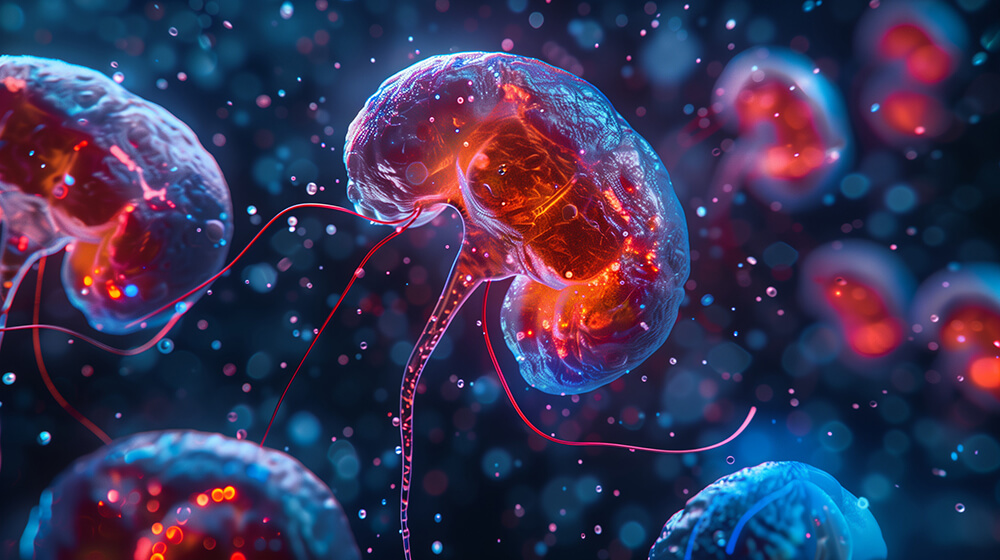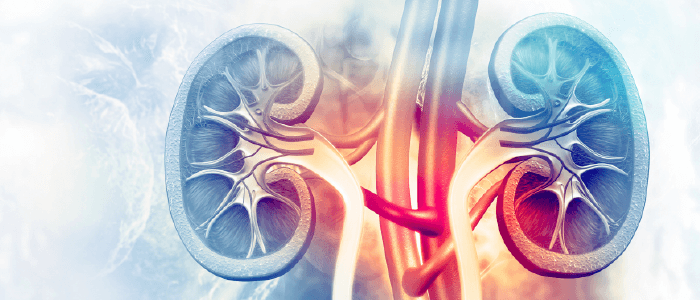<< Back to MOTIFvations Blog Home Page
Multiomic Analysis of Stem Cell-derived Organoids

May 23, 2024
Table of Contents:
-
Introduction: Kidney Organoids in the Laboratory - Even Better Than the Real Thing?
-
The Creation of a Single-cell Multimodal Atlas Highlights the Potential of iPSC-derived Kidney Organoids
-
Multiomic Analysis of the Mesenchymal-to-Epithelial Transition Confirms the Utility of iPSC-derived Kidney Organoids
Introduction: Kidney Organoids in the Laboratory - Even Better Than the Real Thing?
The concerted activity of more than twenty distinct cell types maintains the function of the human kidney. An in-depth understanding of the gene regulatory networks that control the developmental trajectories of cells during kidney organogenesis could support the elaboration of regenerative therapies aimed at patients suffering from diseases such as chronic kidney disease, which affects 9.1% of the world’s population (Cockwell and Fisher).
The collection of samples throughout human kidney development for analysis represents a considerable challenge; however, the generation of kidney “organoids” (Zhao et al.) from human pluripotent stem cells has provided researchers with a model system to study normal kidney development as well as to model disease progression and potentially create replacement cells for therapeutic purposes (Nishinakamura, 2019 and Nishinakamura, 2023). The use of induced pluripotent stem cells (iPSCs) for organoid generation also permits the study of kidney development on a patient-specific and disease-specific basis. Are kidney organoids even better than the real thing?
Here, we report on two fascinating studies that recently assessed the differentiation of human pluripotent stem cell-derived kidney organoids with cutting-edge single-cell epigenetic and transcriptomic techniques in order to define the gene regulatory networks involved during kidney organogenesis. Overall, the findings of these studies highlight the general importance of kidney organoids, which may propel these model systems closer to clinical applications.
The Creation of a Single-cell Multimodal Atlas Highlights the Potential of iPSC-derived Kidney Organoids
A research team guided by Benjamin D. Humphreys (Washington University in St. Louis School of Medicine) sought to explore the alterations to chromatin accessibility that occur during kidney organoid differentiation to define critical gene regulatory networks. Yoshimura et al. induced the formation of kidney organoids from iPSCs and embryonic stem cells following a widely applied protocol (Takasato et al., 2015 and Takasato et al., 2016). They then simultaneously measured RNA and chromatin accessibility in the same cell in each sample collected throughout the 26-day protocol via single-nucleus RNA-sequencing (snRNA-seq) and assay for transposase-accessible chromatin with sequencing (snATAC-seq).
They employed the resultant data to predict cis-regulatory links between open chromatin regions (representing gene regulatory regions containing lineage-specific transcription factor binding sites) and expressed target genes to generate a multimodal atlas of kidney organoid differentiation. This atlas described cell type-specific gene expression and chromatin accessibility profiles and highlighted those transcription factors likely to play crucial roles in directing gene regulatory networks during kidney organoid differentiation.
Comparing cells from day-26 kidney organoids with human adult kidney multiomics data (Muto et al.) revealed that cell-specific marker genes tended to display an open chromatin landscape while gene regulatory regions of maturation-related genes displayed a closed chromatin landscape in differentiating kidney organoid cells compared to the adult kidney. Overall, these findings suggested a degree of “epigenetic immaturity” associated with kidney organoids even though cellular differentiation programs displayed broad conservation. While the authors also noted a matching “immature” gene expression profile in kidney organoids, highly expressed genes displayed similar levels of gene expression and chromatin accessibility to those of the adult kidney to a greater degree than genes with low expression levels.
The authors next examined cell-specific alterations in transcription factor binding motif usage (associated with alterations in chromatin accessibility) to gain insight into the gene regulatory networks driving kidney organogenesis. Chromatin in kidney organoid cells gradually lost accessibility for progenitor-related transcription factors but acquired accessibility for cell type-specific transcription factors, as expected as cells undergo lineage-specific differentiation. Analysis of critical transcription factors controlling kidney organoid cell differentiation highlighted the vital function of HNF1B, with expression varying according to the enrichment of corresponding binding motifs. The fact that HNF1B represents a well-known regulator of kidney development (Heliot et al., Naylor et al., and Massa et al.) suggests that kidney organoids accurately model complex gene regulatory networks and may help to reveal novel insights.
Fascinatingly, the authors validated the data from their multimodal atlas by disrupting a putative gene regulatory network during organoid differentiation by targeting HNF1B gene enhancers via CRISPR interference (Larson et al.). This innovative approach prompted reduced chromatin accessibility and HNF1B gene downregulation and the subsequent impaired specification of the expected kidney cells/tissues. Overall, this finding underscores the utility of kidney organoid models in deciphering and studying those gene regulatory mechanisms that control kidney development.
In summary, this exciting paper – which combines single-cell transcriptomic and epigenetic analyses - offers two notable outcomes: the authors i) highlight human kidney organoids generated according to current protocols as highly utile “stand-ins” for human adult kidney samples for future research and ii) provide a multimodal atlas describing single-cell transcriptome/chromatin accessibility changes during kidney organoid differentiation, which they hope will further illuminate developmental processes and help to explore deficits associated with specific disease states.
For more on how multimodal analysis highlights the potential of iPSC-derived kidney organoids, see PNAS, May 2023.
Multiomic Analysis of the Mesenchymal-to-Epithelial Transition Confirms the Utility of iPSC-derived Kidney Organoids
In our second paper, a research team guided by Katja Röper (MRC-Laboratory of Molecular Biology) aimed to explore the transcriptional mechanisms that control kidney development by evaluating iPSC-derived kidney organoids generated according to previously reported protocols over a period of 24 days (Kumar et al. and Takasato et al., 2015). Specifically, they studied the differentiation of fate-committed mesenchymal progenitors through the so-called “mesenchymal-to-epithelial transition” to the de novo production of nephron epithelial cells (Costantini and Kopan and McMahon, 2016) at the multiomic level in the hope of identifying the critical transcription factors and exploring the gene regulatory networks that control early morphogenetic changes in the developing human kidney.
Ng-Blichfeldt et al. reported that iPSC-derived kidney organoids faithfully recapitulated the renal mesenchymal-to-epithelial transition observed during normal kidney development, thereby highlighting organoids as a robust model for the exploration of critical gene regulatory networks. The multiome profiling of differentiating iPSC-derived kidney organoids via paired snRNA-seq and snATAC-seq revealed dynamic alterations in gene expression and chromatin accessibility, which enabled the definition of correlations between transcription factor gene expression and the genome-wide accessibility of corresponding binding motifs. This data supported the identification of the transcriptional activators and repressors potentially driving the mesenchymal-to-epithelial transition within kidney organoids at single-cell resolution. These transcription factors included SNAI2 and ZEB1, which are well known to directly bind to and repress epithelial genes (Bolós et al. and Eger et al.); therefore, their downregulation may support the progression and completion of the mesenchymal-to-epithelial transition.
The multiomic dataset generated also supported the identification of additional activators and repressors that may play critical roles in the mesenchymal-to-epithelial transition, hence opening up new avenues for future research. Among these factors, the organoid-derived data strongly suggested that PAX8 directly drives the mesenchymal-to-epithelial transition during human kidney development by activating critical cell adhesion genes, including NECTIN3, ITGA6, ITGB8, and BCAM. They employed CRISPR interference to reveal (in disagreement with previous mouse studies (Bouchard et al.) a requirement for the PAX8 transcription factor to initiate the renal mesenchymal-to-epithelial transition downstream of Wnt/β-catenin signaling in human kidney organoids (likely by the activation of a cell-adhesion program). While Wnt/β-catenin signaling specifies a nephron fate, the authors revealed a link between downregulated Wnt signaling and the completion of the mesenchymal-to-epithelial transition and the maturation of the epithelial state via the HNF1B and TEAD transcription factors.
Overall, the multiomic data reported here – again by combining single-cell transcriptomic and epigenetic analyses – confirm human iPSC-derived kidney organoids as a robust model system to understand the gene regulatory networks associated with normal development and, in the future, model disease (including the aforementioned critical case of chronic kidney disease (Shunk et al.) and provide cells for regenerative therapies. Furthermore, the authors also highlight the importance of the interplay between fate commitment and morphogenesis within the developing kidney.
For more on how the multiomic analysis of the mesenchymal-to-epithelial transition confirms the utility of iPSC-derived kidney organoids, see Developmental Cell, March 2024.
About the author

Stuart P. Atkinson, Ph.D.
Stuart was born and grew up in the idyllic town of Lanark (Scotland). He later studied biochemistry at the University of Strathclyde in Glasgow (Scotland) before gaining his Ph.D. in medical oncology; his thesis described the epigenetic regulation of the telomerase gene promoters in cancer cells. Following Post-doctoral stays in Newcastle (England) and Valencia (Spain) where his varied research aims included the exploration of epigenetics in embryonic and induced pluripotent stem cells, Stuart moved into project management and scientific writing/editing where his current interests include polymer chemistry, cancer research, regenerative medicine, and epigenetics. While not glued to his laptop, Stuart enjoys exploring the Spanish mountains and coastlines (and everywhere in between) and the food and drink that it provides!
Contact Stuart on Twitter with any questions
Related Articles
Inflammaging – What Epigenetic Associations with Kidney Health Can Tells Us
October 25, 2022
Inflammaging is a somewhat new, but very engaging concept – how does our immune system affect the aging process? Here we look at research describing how accelerated epigenetic aging detected in the blood correlates with reduced kidney health as an example. These links may provide a means to further our understanding of inflammaging, and how to combat this chronic low-grade inflammatory process that may contribute to age-related disease development.
Read More
Complete Guide to Understanding and Using ATAC‑Seq
February 9, 2021
The ATAC-Seq method was just published in 2013 and it has already become one of the most common and powerful ways to study chromatin states on a genome-wide level. This article covers what ATAC-Seq is and how to use it in your research.
Read More
Multiomic Epigenetic Analysis Turns Short Stories into Epic Tales
March 9, 2022
A multiomics-based approach to epigenetic research through the combination of multiple next-generation techniques has the potential to turn any short scientific tale into an epic multilayered story of gene regulation!
Read More
What Can Histone Methylation Patterns in Kidney Cancer Teach Us About Disease Progression & New Treatments Options?
June 19, 2019
Renal cell carcinoma (RCC) is one of the 10 most common cancers in both men and women in the United States and existing treatments are often not effective. New epigenetic drugs might be the answer.
Read More
<< Back to MOTIFvations Blog Home Page










